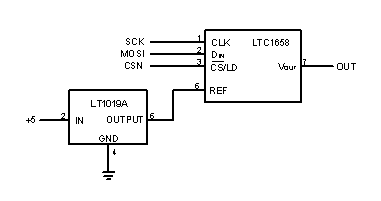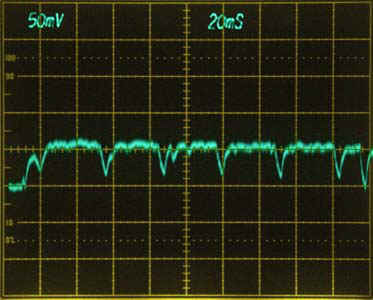LabJackJNI
| Introduction |
| Examples |
| LabJackWrapper |
| JavaDoc |
| Download |
| Project Page |
| License |
| Links |
Here's an example of adding an external D/A converter to achive much higher resolution and accuracy compared to the LabJack's existing two analog outputs, which suffers from a rather significant noise problem. The circuit above uses a Linear Technology LTC1658 14-bit D/A converter. The LT1019A is a 2.5 volt reference. A problem with the CS pin (extra clock pulse) prevents read-back from working properly, meaning this device can't be included in an SPI loop used for read-back. In practice this isn't a problem as you can still attach it to the LabJack's SPI pins - just use a different CS pin than ones used for read-back and place it in a write-only SPI chain. The LabJack SPI mode pin-out is shown in the following table.
The following sample code utilizes the LabJackWrapper class to write the D/A. LabJackWrapper labjack = new LabJackWrapper( -1 ); int spiMode = 2; // dac output ok, but read-back doesn't work int spiMsDelay = 0; int spiHusDelay = 0; int spiControlCS = 1; // >1 means we want LabJack to implement and control a chip select pin for us int spiCsLine = 0; // '0' means use D0 as the chip select line int spiCsState = 0; // specify active state (low) of chip select line, i.e. CSN int spiConfigD = 1; // we want LabJack to configure I/O pins for us labjack.configSPI( spiMode, spiMsDelay, spiHusDelay, spiControlCS, spiCsLine, spiCsState, spiConfigD ); GenericSPI dac = new GenericSPI( 14 ); GenericSPI unused = new GenericSPI( 2 ); labjack.addSPI( dac ); labjack.addSPI( unused ); // LTC1658 has two dummy bitsdac.setBits( 16383 ); // set output to 2.5V LabJack Analog Output Noise The image below shows an actual noise measurement on the LabJack +5 volt supply. While the analog outputs are filtered, this noise still feeds through and reduces the effective resolution of the 10-bit analog outputs. This noise was measured while the LabJack was active and appears to be related to dynamic current consumption during USB communications. |
| Copyright (c) Kris Kusumoto 2004 Last Updated: 05-FEB-04 |
Hosted By |

